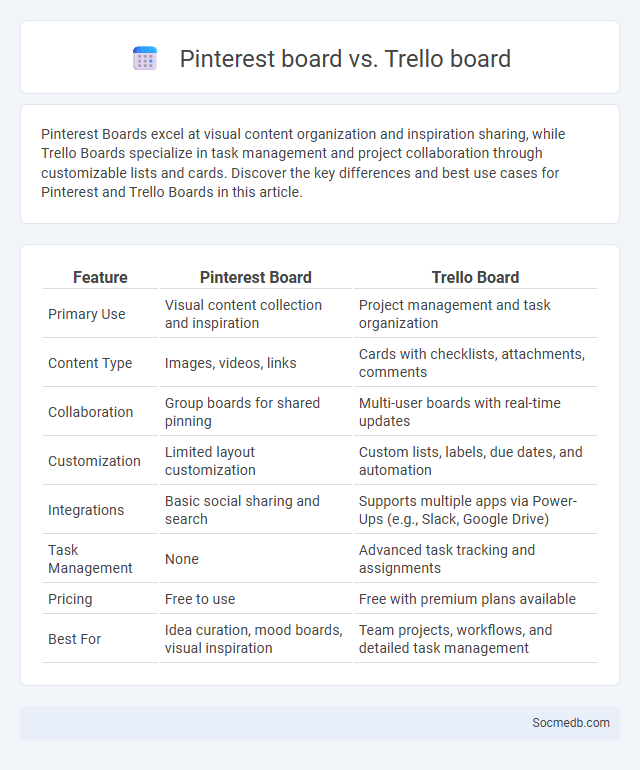
Photo illustration: Pinterest Board vs Trello Board
Pinterest Boards excel at visual content organization and inspiration sharing, while Trello Boards specialize in task management and project collaboration through customizable lists and cards. Discover the key differences and best use cases for Pinterest and Trello Boards in this article.
Table of Comparison
| Feature | Pinterest Board | Trello Board |
|---|---|---|
| Primary Use | Visual content collection and inspiration | Project management and task organization |
| Content Type | Images, videos, links | Cards with checklists, attachments, comments |
| Collaboration | Group boards for shared pinning | Multi-user boards with real-time updates |
| Customization | Limited layout customization | Custom lists, labels, due dates, and automation |
| Integrations | Basic social sharing and search | Supports multiple apps via Power-Ups (e.g., Slack, Google Drive) |
| Task Management | None | Advanced task tracking and assignments |
| Pricing | Free to use | Free with premium plans available |
| Best For | Idea curation, mood boards, visual inspiration | Team projects, workflows, and detailed task management |
Introduction to Digital Boards
Digital boards revolutionize social media management by allowing real-time content display and interactive engagement across multiple platforms. Your business can leverage digital boards to showcase dynamic campaigns, monitor social media trends, and enhance audience interaction through visually compelling presentations. Integrating digital boards into your social media strategy boosts brand visibility and streamlines communication with target audiences.
What Is a Pinterest Board?
A Pinterest board is a curated collection of pins organized around a specific theme or interest, allowing you to visually save and categorize ideas, products, or inspirations. Each board helps you easily access and share your favorite content, enhancing your ability to plan projects, discover trends, or promote brands. Managing Pinterest boards effectively can boost your engagement and streamline your creative process on the platform.
What Is a Trello Board?
A Trello board is a visual project management tool that helps you organize tasks using lists and cards. Each board represents a project where you can track progress, assign responsibilities, and set deadlines, enhancing team collaboration and productivity. Your efficient workflow benefits from Trello's intuitive design, making project tracking straightforward and customizable.
Defining the Generic "Board" Concept
The generic "board" concept in social media platforms refers to a digital space where users can collect, organize, and share content such as images, links, videos, and text posts around specific themes or interests. Boards facilitate community engagement by enabling collaboration, discussion, and discovery within niche topics, enhancing user interaction and content curation. Key features include customizable layouts, tagging systems, and integration with broader social networks to maximize visibility and user participation.
Core Features Comparison
Social media platforms excel in distinct core features, with Facebook offering robust community building through groups and event management, while Instagram emphasizes visual content sharing via photos and short videos. Twitter specializes in real-time information dissemination with character-limited posts and trending hashtag tracking, whereas LinkedIn targets professional networking by highlighting career achievements and job listings. TikTok's unique algorithm-driven content delivery focuses on short-form video engagement, fostering rapid viral trends and user interaction.
Use Cases: Pinterest vs Trello vs Board
Pinterest excels in visual content discovery and inspiration, making it ideal for creative projects, fashion trends, and home decor ideas. Trello serves as a powerful project management tool with boards, lists, and cards designed to streamline team collaboration, task tracking, and workflow organization. Board combines the visual appeal of Pinterest with task management features like Trello, offering a hybrid platform for planning events, managing projects, and brainstorming ideas in a visually organized manner.
Collaboration and Sharing Capabilities
Social media platforms enhance collaboration and sharing capabilities by enabling users to connect, communicate, and exchange information instantaneously across diverse networks. Your ability to co-create content, participate in group discussions, and share multimedia resources boosts productivity and drives collective innovation. These features foster real-time engagement, support project teamwork, and facilitate the dissemination of ideas on a global scale.
Visual Organization and Customization
Visual organization on social media enhances your content's impact by using consistent color schemes, layouts, and typography that align with your brand identity. Customization tools enable you to tailor posts with filters, stickers, and templates, increasing engagement and making your message more memorable. By mastering these elements, your profile stands out in crowded feeds, attracting a targeted audience effectively.
Integration with Other Tools
Integrating social media platforms with customer relationship management (CRM) systems and email marketing tools enhances your ability to track engagement and personalize interactions. Automated workflows connecting social media analytics with project management software streamline content scheduling and performance monitoring. Such integrations empower your marketing strategy by consolidating data sources for comprehensive insights and efficient campaign execution.
Choosing the Right Board for Your Needs
Selecting the ideal social media management board depends on your specific goals, whether it's content scheduling, audience engagement, or analytics tracking. Platforms like Trello offer visual task management, while tools like Hootsuite specialize in comprehensive social media monitoring and performance metrics. Prioritize features that align with your brand's strategy, such as collaboration tools, customizable workflows, and integration with multiple social networks to optimize efficiency.
 socmedb.com
socmedb.com